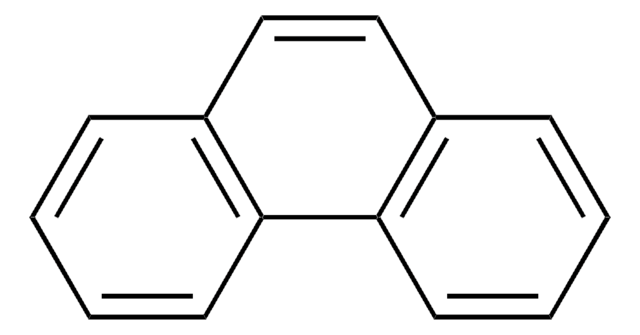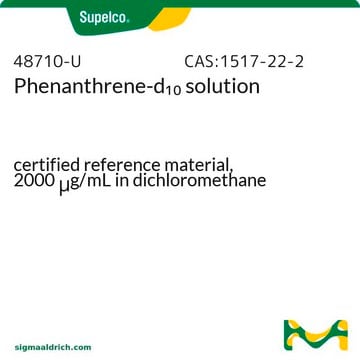48569
Phenanthrene
analytical standard, for environmental analysis
Sign Into View Organizational & Contract Pricing
Select a Size
All Photos(1)
Select a Size
Change View
About This Item
Empirical Formula (Hill Notation):
C14H10
CAS Number:
Molecular Weight:
178.23
Beilstein/REAXYS Number:
1905428
EC Number:
MDL number:
UNSPSC Code:
12352200
PubChem Substance ID:
Recommended Products
grade
analytical standard
Quality Level
CofA
current certificate can be downloaded
packaging
ampule of 5000 mg
technique(s)
HPLC: suitable
gas chromatography (GC): suitable
bp
340 °C (lit.)
mp
98-100 °C (lit.)
density
1.063 g/mL at 25 °C (lit.)
application(s)
environmental
format
neat
Looking for similar products? Visit Product Comparison Guide
General description
Phenanthrene is a polycyclic aromatic hydrocarbon often formed by incomplete combustion of organic materials.
Application
Phenanthrene may be used as an analytical reference standard for the determination of the analyte in various biological matrices at trace levels using gas chromatography-mass spectrometry.
Refer to the product′s Certificate of Analysis for more information on a suitable instrument technique. Contact Technical Service for further support.
signalword
Warning
hcodes
Hazard Classifications
Acute Tox. 4 Oral - Aquatic Acute 1 - Aquatic Chronic 1
Storage Class
11 - Combustible Solids
wgk_germany
WGK 2
flash_point_f
Not applicable
flash_point_c
Not applicable
Choose from one of the most recent versions:
Already Own This Product?
Find documentation for the products that you have recently purchased in the Document Library.
Customers Also Viewed
Determination of phenanthrene and hydroxyphenanthrenes in various biological matrices at trace levels using gas chromatography-mass spectrometry.
Grova N, et al.
Journal of Analytical Toxicology, 29(3), 175-181 (2005)
Catherine A Matulis et al.
Current biology : CB, 30(2), 222-236 (2020-01-14)
In visual systems, neurons adapt both to the mean light level and to the range of light levels, or the contrast. Contrast adaptation has been studied extensively, but it remains unclear how it is distributed among neurons in connected circuits
Marino Marinković et al.
Environmental science & technology, 46(22), 12679-12686 (2012-11-07)
Cellular stress responses are frequently presumed to be more sensitive than traditional ecotoxicological life cycle end points such as survival and growth. Yet, the focus to reduce test duration and to generate more sensitive end points has caused transcriptomics studies
Yulong Zhang et al.
Chemosphere, 90(6), 1973-1979 (2012-12-04)
Two sediments were demineralized and sequentially fractionated into extracted fractions [free lipid (FL), bound lipid (BL) and lignin (LG)] and residual fractions [free lipid free (FLF), bound lipid free (BLF) and lignin free (LGF)]. The sorption isotherms of phenanthrene (Phen)
Identification of soil bacteria able to degrade phenanthrene bound to a hydrophobic sorbent in situ.
Raïssa Kom Regonne et al.
Environmental pollution (Barking, Essex : 1987), 180, 145-151 (2013-06-19)
Efficient bioremediation of PAH-contaminated sites is limited by the hydrophobic character and poor bioavailability of pollutants. In this study, stable isotope probing (SIP) was implemented to track bacteria that can degrade PAHs adsorbed on hydrophobic sorbents. Temperate and tropical soils
Our team of scientists has experience in all areas of research including Life Science, Material Science, Chemical Synthesis, Chromatography, Analytical and many others.
Contact Technical Service










![Benzo[a]pyrene analytical standard, for environmental analysis](/deepweb/assets/sigmaaldrich/product/structures/253/820/be96d879-1811-46c0-8f11-612019691c2d/640/be96d879-1811-46c0-8f11-612019691c2d.png)
![Indeno[1,2,3-cd]pyrene analytical standard](/deepweb/assets/sigmaaldrich/product/structures/231/153/b0b230c2-efa0-4f43-a261-66b931ead3d2/640/b0b230c2-efa0-4f43-a261-66b931ead3d2.png)
![Benzo[ghi]perylene analytical standard](/deepweb/assets/sigmaaldrich/product/structures/154/740/c50ff1be-dfb4-4159-a98c-9cecf9206ad3/640/c50ff1be-dfb4-4159-a98c-9cecf9206ad3.png)
